Related Research Articles
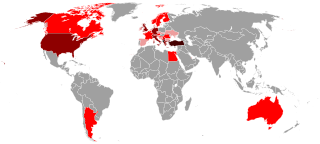
The Albanians are an ethnic group native to the Balkan Peninsula who share a common Albanian ancestry, culture, history and language. They primarily live in Albania, Kosovo, North Macedonia, Montenegro, Serbia as well as in Croatia, Greece, Italy and Turkey. They also constitute a large diaspora with several communities established across Europe, the Americas and Oceania.
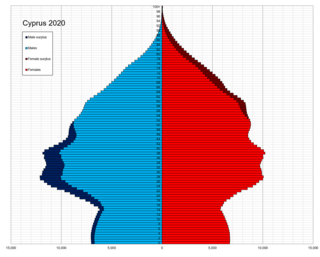
The people of Cyprus are broadly divided into two main ethnic communities, Greek Cypriots and Turkish Cypriots, who share many cultural traits but maintain distinct identities based on ethnicity, religion, language, and close ties with Greece and Turkey respectively. Before the dispute started in 1964 the peoples of Cyprus were dispersed over the entire island.
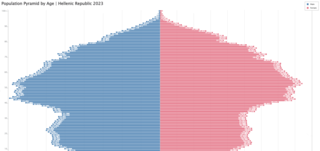
The Demographics of Greece refer to the demography of the population that inhabits the Greek peninsula. The population of Greece was estimated by the United Nations to be 10,445,365 in 2021.
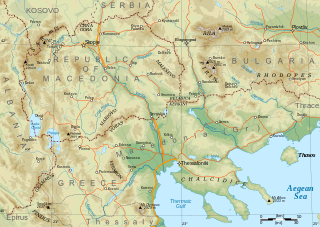
Macedonia is a geographical and historical region of the Balkan Peninsula in Southeast Europe. Its boundaries have changed considerably over time; however, it came to be defined as the modern geographical region by the mid-19th century. Today the region is considered to include parts of six Balkan countries: all of North Macedonia, large parts of Greece and Bulgaria, and smaller parts of Albania, Serbia, and Kosovo. It covers approximately 67,000 square kilometres (25,869 sq mi) and has a population of around five million. Greek Macedonia comprises about half of Macedonia's area and population.

Demographic features of the population of Albania include population density, ethnicity, education level, health of the populace, economic status, religious affiliations and other aspects. The demography of the Albania is monitored by the Institute of Statistics of Albania. The institute has performed demographic censuses since the 1920s. The latest census in Albania was performed in April 2011, and has been deemed as unreliable both within and outside Albania.

Phocis is one of the regional units of Greece. It is part of the administrative region of Central Greece. It stretches from the western mountainsides of Parnassus on the east to the mountain range of Vardousia on the west, upon the Gulf of Corinth. It is named after the ancient region of Phocis, but the modern regional unit also includes parts of ancient Aetolia, Locris and Doris.

Greece is a town in Monroe County, New York, United States. A suburb of Rochester, New York, it is the largest town by population in Monroe County, and the second-largest municipality by population in the county, behind only the City of Rochester. As of April, 2023, the town has a population of 94,591.

Eastern Rumelia was an autonomous province of the Ottoman Empire with a total area of 32,978 km2, which was created in 1878 by virtue of the Treaty of Berlin and de facto ceased to exist in 1885, when it was united with the Principality of Bulgaria, also under nominal Ottoman suzerainty. It continued to be an Ottoman province de jure until 1908, when Bulgaria declared independence. Ethnic Bulgarians formed a majority of the population in Eastern Rumelia, but there were significant Turkish and Greek minorities. Its capital was Plovdiv. The official languages of Eastern Rumelia were Bulgarian, Greek and Ottoman Turkish.
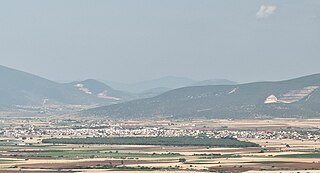
Almyros or Halmyros is a town and a municipality of the regional unit of Magnesia, region of Thessaly, Greece. It lies in the center of prosperous fertile plain known as 'Krokio Pedio', which is crossed by torrents. Almyros is an important agricultural and commercial center of Magnesia, and is also developing as a tourist center for the area. The main agricultural products are tomatoes, cotton, wheat, almonds, peanuts and pistachio nuts.
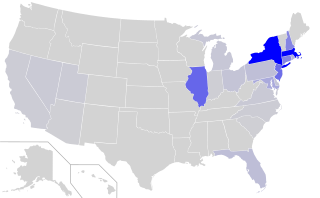
Greek Americans are Americans of full or partial Greek ancestry. The lowest estimate is that 1.2 million Americans are of Greek descent while the highest estimate suggests over 3 million. According to the US census, 264,066 people older than five spoke Greek at home in 2019.
The 2001 Canadian census was a detailed enumeration of the Canadian population. Census day was May 15, 2001. On that day, Statistics Canada attempted to count every person in Canada. The total population count of Canada was 30,007,094. This was a 4% increase over 1996 census of 28,846,761. In contrast, the official Statistics Canada population estimate for 2001 was 31,021,300. This is considered a more accurate population number than the actual count.
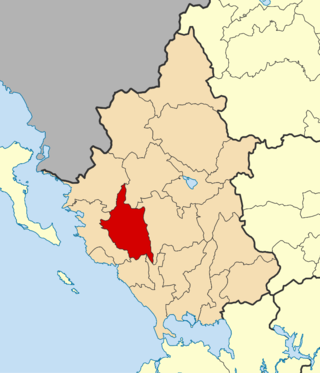
Souli is a municipality in Epirus, northwestern Greece. The seat of the municipality is the town of Paramythia.

Eordaia is a municipality in the Kozani regional unit, Western Macedonia, Greece. The seat of the municipality is the town Ptolemaida. The municipality has an area of 708.807 km2. The population was 42,515 in 2021.

The Greek diaspora, also known as Omogenia, are the communities of Greeks living outside of Greece and Cyprus.
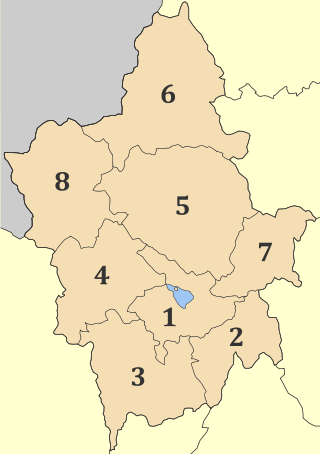
Ioannina is one of the regional units of Greece, located in the northwestern part of the country.

Epirus is a traditional geographic and modern administrative region in northwestern Greece. It borders the regions of Western Macedonia and Thessaly to the east, West Greece to the south, the Ionian Sea and Ionian Islands to the west and Albania to the north. The region has an area of about 9,200 km2 (3,600 sq mi). It is part of the wider historical region of Epirus, which overlaps modern Albania and Greece but lies mostly within Greek territory.

Delvinë ; is a town and a municipality in Vlorë County, southern Albania, 16 kilometres northeast of Saranda. It was formed in the 2015 local government reform by the merger of the former municipalities Delvinë and Vergo, which became municipal units. The seat of the municipality is the town Delvinë. The total population is 7,598, in a total area of 183.01 square kilometres. The population of the former municipality in the 2011 census was 5,754.
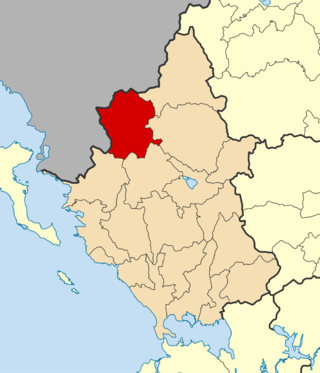
Pogoni is a municipality in the Ioannina regional unit, Epirus, Greece. The seat of the municipality is the village Kalpaki. The municipality has an area of 701.059 km2. Its population was 6,848 at the 2021 census.
The Greeks of Toronto comprises Greek immigrants and their descendants living in Toronto, Canada.
References
- ↑ "Greek censuses (in Greek)". Archived from the original on 2014-01-16. Retrieved 2007-07-25.
- ↑ Population exchange in Greek Macedonia, Elisabeth Kontogiorgi, page 50, 2006